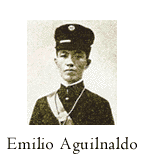American
Designs and the Benevolent Assimilation
The
events of February 1899 did not come as a total shock.
As early as August 1898, Filipinos started doubting
U.S. altruism in coming to their aid against the Spaniards.
On August 13, 1898, the Spaniards surrendered Manila
to the Americans after a staged, mock battle aimed at
displaying some semblance of Spanish resistance as a
way of avoiding loss of face. To avoid their total humiliation,
the Spaniards also insisted on the exclusion of the
Filipinos in the capitulation drama. Once Manila was
secured, the Americans insisted on restricting Filipino
forces to specific areas outside the walled city of
Manila, Intramuros. Suspicions heightened after the
continued arrival of American reinforcements in the
country despite the surrender of Spain. The strengthening
of the U.S. forces in the Philippines convinced many
Filipinos that the Americans were gearing for another
war. This skepticism crystallized during the deliberation
of the Treaty of Paris that December when the Filipinos
were again excluded from the negotiations between the
United States and Spain. Amid the protestations of Filipino
representatives who were in Paris despite their exclusion,
the U.S. and Spain signed the treaty on December 10,
1898. The February 4th incident was a mere formality
of what the Filipinos had suspected all along.
At
the turn of the century, the economy of the United States
was growing by leaps and bounds. American business interests
favored the overseas  expansion
of the U.S. market and were eyeing China which was at
this time being partitioned into spheres of influence
by Western powers. Many U.S. leaders viewed the Philippines
as a possible colony and base from which U.S. claims
on China could be launched. While economic interest
was preeminent, many Americans were also imbued with
a "civilizing" zeal. White Man’s burden
was often cited to justify U.S. annexation of the Philippines.
In his Benevolent Assimilation Proclamation, U.S.
President William McKinley argued that the Americans
must educate, civilize, and uplift the conditions of
the Filipinos. This self-righteous ideology, partly
due to ignorance of the history of the Filipinos, was
conveniently used by the Americans to rationalize their
actions throughout the colonial period. The Filipinos
had to be guided to "maturity" and "enlightenment"
so that they may reap the fruits of American "tutelage"
and "beneficence." To effect this "mission
and vision," the United States must subdue any
form of Filipino resistance, after all they were deemed
"ignorant, uneducated, and uncivilized." expansion
of the U.S. market and were eyeing China which was at
this time being partitioned into spheres of influence
by Western powers. Many U.S. leaders viewed the Philippines
as a possible colony and base from which U.S. claims
on China could be launched. While economic interest
was preeminent, many Americans were also imbued with
a "civilizing" zeal. White Man’s burden
was often cited to justify U.S. annexation of the Philippines.
In his Benevolent Assimilation Proclamation, U.S.
President William McKinley argued that the Americans
must educate, civilize, and uplift the conditions of
the Filipinos. This self-righteous ideology, partly
due to ignorance of the history of the Filipinos, was
conveniently used by the Americans to rationalize their
actions throughout the colonial period. The Filipinos
had to be guided to "maturity" and "enlightenment"
so that they may reap the fruits of American "tutelage"
and "beneficence." To effect this "mission
and vision," the United States must subdue any
form of Filipino resistance, after all they were deemed
"ignorant, uneducated, and uncivilized."
After
suffering three hundred years of Spanish rule and shedding
their blood for independence, the Filipinos were not
willing to accept a new colonial order, and they naturally
resisted U.S. designs on the Philippines. According
to Luzviminda Francisco, the Philippine-American War
was a forgotten war in the U.S. annals. American textbooks
contain several pages on the Spanish-American War but
only devote a paragraph on the Philippine-American War
despite the fact that the latter was more pronounced
in terms of duration, scale, and number of casualties.
The war was ugly, ruthless, and brutal prompting Stanley
Karnow to describe it as "among the cruelest conflicts
in the annals of Western imperialism." Other scholars
referred to the conflict as the United States’
"first Vietnam." Luzviminda estimates that
as much as 126,000 American soldiers, or 3/4 of the
U.S. army, were shipped to the Philippines, and at least
600,000 Filipinos died during the war. American anti-imperialist
Mark Twain claims that Filipino casualties was close
to one million or the equivalent of 1/6 of the country’s
total population at the turn of the century.
 Casualties
aside, the terminology of the conflict has been misconstrued
for a long time. The Americans called the Philippine-American
War an insurgency, mainly because they refused to recognize
the Philippine independence proclaimed by Aguinaldo.
Recognition would have portrayed the Americans in an
unflattering way, i.e, imperialists who were seizing
an independent country. The American refusal to recognize
the legitimacy of the Filipino struggle had them brand
Filipino soldiers as bandits or ladrones. Casualties
aside, the terminology of the conflict has been misconstrued
for a long time. The Americans called the Philippine-American
War an insurgency, mainly because they refused to recognize
the Philippine independence proclaimed by Aguinaldo.
Recognition would have portrayed the Americans in an
unflattering way, i.e, imperialists who were seizing
an independent country. The American refusal to recognize
the legitimacy of the Filipino struggle had them brand
Filipino soldiers as bandits or ladrones.
|

